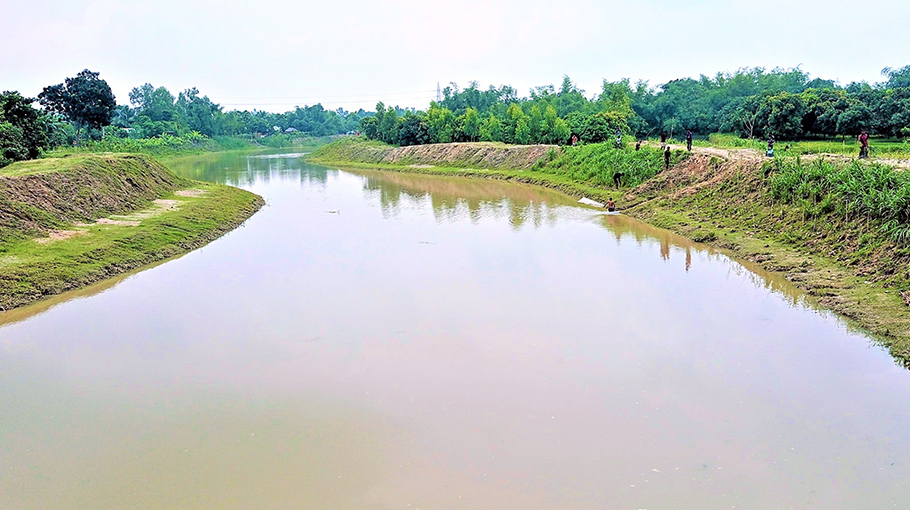Once dead Teesta alive again Work on river revival projects goes on in full swing in Rangpur

Once the Dead Teesta is now flowing in clear water. Ducks are playing in the river, flocks are coming and flocks are growing, and the presence of the fisherman is also moving. After the excavation, life has returned to the 'Dead Teesta' river in Rangpur, which has been lost to human occupation and pollution for almost 200 years. Farmers are also using the water of the river for irrigation as they are happy to get back the source of water.
Sometimes, rivers loose its normal course due to earthquakes and severe floods. The people Have been sitting in the lifeless river for a long amount of time. Homes, ponds and paddy lands have been built on the banks of the river. The Barind Multipurpose Development Authority (BMDA) is working to revive such a missing river in Rangpur. The river 'Dead Teesta', which was recently lost from the map, has been excavated. The dead Teesta seems to be waking up after almost 200 years as the 13.50 km section of this tributary river, which was lost in the evolution of time, was rescued and excavated from the occupiers. Various fruit, forest and medicinal plant saplings have been planted in the environment development including conservation of its two sides.
Sources said that a tributary of the Teesta flows through the southern part of Jalpaiguri district of West Bengal, India and enters through Domar upazila of Nilphamari district of Bangladesh. It then passes through Nilphamari district, flows through Taraganj, Badarganj upazila of Rangpur district and joins Karatoya River at the end of Mithapukur upazila. The once dead Teesta was a flowing river. When this tributary river separates from the Teesta, it becomes known locally as Charalkata, Yamuneshwari and Deonai. At one time the dead Teesta began to get narrow in the hands of the occupiers. The normal flow of the river is stopped. Occupancy and filling that river turned into paddy land, cattle pasture. Starting from the playground, there were houses on the river bank. Earlier, during floods, it maintained the flow of Chikli and Yamuneshwari rivers. About five thousand hectares of land is inundated and flooded every year due to the closure of that stream. Due to lack of river, many fishermen lost their jobs and became unemployed.
In such a situation, the Barind Multipurpose Development Authority has drawn up a plan to rescue and release the missing rivers. Under their initiative, dredging of canals and small rivers was started in the greater Rangpur district through the Irrigation Extension Project (EIRP) through optimal use of water and conservation of rain water. As part of this, the river was excavated by identifying the area of the lost dead river Teesta in Badarganj. Authorities say the 13.50-kilometer-long tributary of the Dead Teesta is connected to the Chikli River by crossing the Badarganj Upazila Parishad, Sardarpara, Baniapara, Kumarpara, Shankarpur, Jharpara, Sarkarpara, Kalupara and Bairampur. As a result, Badarganj Upazila Sadar will be protected from floods. People have the opportunity to use surface water in their daily work. Besides, duck and fish farming as well as stored water can be used for irrigation.
Ainul Haque, a farmer from Shankarpur Dangarpara village in Kalupara union on the banks of the Dead Teesta, said, "It was a river during the time of our forefathers. We caught a lot of fish. After a long time now there is water in the river. There are many benefits for those of us who cultivate along the river.” Tuhin Wadud said the region would bring unimaginable positive results to agriculture, biodiversity and the environment.
Habibur Rahman Khan, supervising engineer of Barind Multipurpose Development Project Rangpur, said the rivers have been flooded for a long time due to lack of reforms. This resulted in waterlogging, floods and severe damage to crops. Waterlogged lands are now becoming suitable for cultivation. Now that the dead Teesta has regained its lost youth, 5,000 hectares of waterlogged land in 20 villages along the river is now suitable for tea. The rescued river will play a role in maintaining the balance of water reservoir, source of protein and environment.




